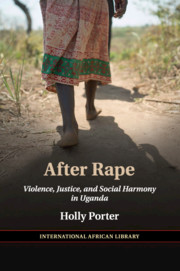Book contents
- After RapeViolence, Justice, and Social Harmony in Uganda
- The International African Library
- After Rape
- Copyright page
- Dedication
- Contents
- Figures
- Acknowledgements
- Abbreviations and Acronyms
- 1 Introduction
- 2 Life and participant reflection in northern Uganda
- 3 Rape, wrongdoing, and justice
- 4 Acholi love
- 5 Consent and rape
- 6 Social harmony and the space between local solutions and judicial systems
- 7 Mango trees, offices, and altars
- 8 Comparing the aftermath of civilian and combatant rape
- 9 Conclusion
- References
- Index
- Series page
- References
References
Published online by Cambridge University Press: 20 January 2017
- After RapeViolence, Justice, and Social Harmony in Uganda
- The International African Library
- After Rape
- Copyright page
- Dedication
- Contents
- Figures
- Acknowledgements
- Abbreviations and Acronyms
- 1 Introduction
- 2 Life and participant reflection in northern Uganda
- 3 Rape, wrongdoing, and justice
- 4 Acholi love
- 5 Consent and rape
- 6 Social harmony and the space between local solutions and judicial systems
- 7 Mango trees, offices, and altars
- 8 Comparing the aftermath of civilian and combatant rape
- 9 Conclusion
- References
- Index
- Series page
- References
- Type
- Chapter
- Information
- After RapeViolence, Justice, and Social Harmony in Uganda, pp. 229 - 247Publisher: Cambridge University PressPrint publication year: 2016

